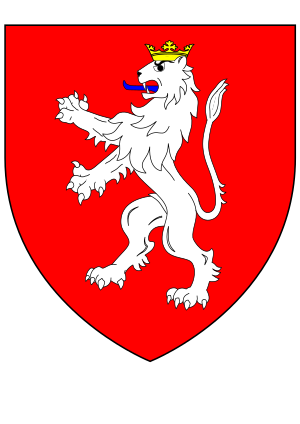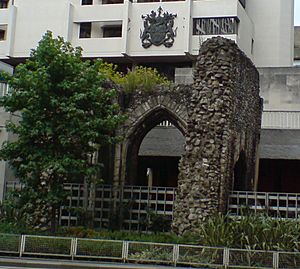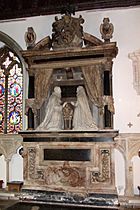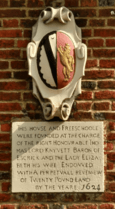Rowland Hayward facts for kids
Quick facts for kids
Sir Rowland Hayward
|
|
|---|---|

Arms of Hayward of Essex: Gules, a lion rampant argent crowned or
|
|
| Born | c. 1520 |
| Died | 5 December 1593 |
| Buried | St Alphage London Wall |
| Spouse(s) | Joan Tillesworth Katherine Smythe |
| Issue | Sir George Hayward Sir John Hayward four sons who died as infants Elizabeth Hayward Susan Hayward Joan Hayward Alice Hayward Katherine Hayward Mary Hayward Anne Hayward three daughters who died as infants |
| Father | George Hayward |
| Mother | Margaret Whitbrooke |
Sir Rowland Hayward (around 1520 – 5 December 1593) was a very successful merchant in London. He became the Lord Mayor of London twice, first in 1570 and again in 1591. He earned a lot of money from his business activities. This wealth allowed him to lend money to Queen Elizabeth I. He also bought many properties in different parts of England and several homes in and near London. In 1587, he even hosted Queen Elizabeth at his country home, King's Place.
Contents
Sir Rowland Hayward: A Powerful Londoner
Early Life and Training
Rowland Hayward was the oldest son of George Hayward and Margaret Whitbrooke. His father, George, was a shoemaker from Bridgnorth, a town in Shropshire. George Hayward was also a Member of Parliament for Bridgnorth and an alderman (a senior member of the town council).
Rowland went to school in Bridgnorth. When he was about twelve years old, he moved to London. There, he became an apprentice to a clothworker. This meant he learned the trade of making and selling cloth. By 1541 or 1542, he had finished his training and became a full member of the Clothworkers' Company.
Becoming a City Leader
Sir Rowland Hayward quickly became an important person in London. In 1558, he attended the grand celebration for Queen Elizabeth I's coronation. The next year, he became the Master of the Clothworkers' Company.
In 1560, he was chosen as an Alderman. This was a very important position, only for wealthy citizens. In the same year, he helped the City of London by lending £1000 to buy wheat. He also became the President of Bridewell Hospital in 1561. He continued to help manage London's hospitals until he died. From 1563 to 1564, he served as a Sheriff of London.
Building a Fortune
Hayward became one of London's top business leaders. Before 1563, he was already trading with Antwerp in Europe. He was part of the Company of Merchant Adventurers. This group exported English cloth to other countries. They also imported materials like fustian (a thick cotton fabric) and luxury fabrics like camlet and silk. In 1565, he helped start the famous Royal Exchange in London, which was a center for trade.
He was also a founding member of the Muscovy Company. This company traded with Russia. He was the Governor of this company eight times between 1567 and 1587. He was mentioned as a leading merchant when Czar Ivan the Terrible gave the company special trading rights in 1567. He also got similar rights from the Shah of Persia in 1570.
From 1568 onwards, he was also the Governor of the Company of Mineral and Battery Works. In 1570, he was elected Lord Mayor of London and was made a knight in 1571. In 1572, he was elected to Parliament for the City of London. He worked on many important committees there. In the same year, he became President of St Bartholomew's Hospital, a role he kept until his death.
He served as Lord Mayor again in 1591. He took over after Sir John Allot passed away before finishing his term.
His Homes and the Queen
Sir Rowland Hayward's growing wealth allowed him to buy a lot of property. By 1553, he owned land in four different counties. Some of this land became available after the dissolution of the monasteries (when King Henry VIII closed down many religious houses). When he died in 1593, he owned seventeen large estates in several counties. He also had a house in London and another just outside the city.
His London house was built on the site of an old religious building called the Priory of St Mary the Virgin. This house was near the church of St Alphage. His country home was King's Place in Hackney. This house had once belonged to King Henry VIII. In 1587, Queen Elizabeth I visited King's Place. She was on her way to Lord Burghley's house, Theobalds.
Sir Rowland Hayward passed away on 5 December 1593 at King's Place. He was buried at the church of St Alphage London Wall. A special monument was built there to remember him. It shows Sir Rowland with his two wives and all their children.
In his will, he left a third of his property to his wife and another third to his children. The rest he used for gifts, including money for charity. He asked for his house, King's Place, to be sold.

Family Life
Sir Rowland Hayward was married twice.
His first wife was Joan Tyllesworth. They married in July 1546. Joan was the daughter of a London goldsmith. According to his monument, they had three sons and two daughters who passed away as babies. They also had three daughters who grew up:
- Elizabeth Hayward: She married Sir Richard Warren and later Thomas Knyvet, 1st Baron Knyvet.
- Susan Hayward: She married Sir Henry Townshend.
- Joan Hayward: She married John Thynne.
Joan passed away in 1580.
Sir Rowland then married Katherine Smythe when she was only sixteen. She was the daughter of Thomas Smythe, a customs officer in London. With Katherine, he had a son and a daughter who died as babies. They also had two sons and four daughters who survived:
- Sir George Hayward: He passed away in 1615 without having children.
- Sir John Hayward: He inherited a lot of money from his older brother. He also passed away without having children.
- Alice Hayward: She married Sir Richard Buller.
- Katherine Hayward: She married Richard Scott.
- Mary Hayward: She married Sir Warham St Leger.
- Anne Hayward: She married Edward Craford.
After Sir Rowland Hayward died, his widow, Katherine, married Sir John Scott.



